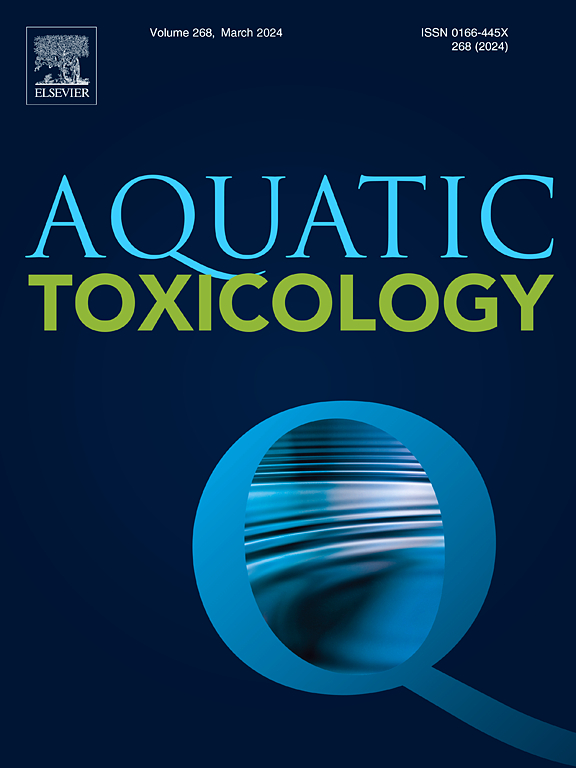综合生理、能量代谢和代谢反应显示了万年青肝胰脏对亚硝酸盐胁迫的应激反应。
IF 4.1
2区 环境科学与生态学
Q1 MARINE & FRESHWATER BIOLOGY
引用次数: 0
摘要
亚硝酸盐是饲养水中的一种有毒物质,会影响对虾的健康。肝胰腺是对虾重要的消化、免疫和代谢器官。本研究将对虾(Litopenaeus vannamei)分别暴露于1毫克/升和5毫克/升的亚硝酸盐胁迫48小时,通过综合组织学、生理指标、能量代谢和代谢组学等方法探讨亚硝酸盐对肝胰腺的毒性。亚硝酸盐胁迫诱导了肝胰腺的形态变化和应激反应。具体来说,生理相关指标,如抗氧化剂(ROMO1、Nrf2、GPx)、内质网应激(Bip、IRE1和XBP1)和免疫基因(ALF、Pen-3、Lys)的相对基因表达水平降低,而细胞凋亡(Casp-3)、解毒(CYP450)和谷氨酸草酰乙酸转氨酶(GOT)活性的基因表达水平升高。渗透调节相关酶(NKA、CMA 和 ATPase)的活性也有所下降。能量代谢相关指标,如丙酮酸和肝糖原含量增加,而葡萄糖、乳酸、甘油三酯和 ATP 含量及 ATP 酶活性降低,碳水化合物代谢(PDH、碳水化合物代谢(PDH、HK 和 LDH)和电子传递链基因(CytC、COI 和 CCO)的相对基因表达水平下降,脂质代谢(AMPK、SREBP 和 FAS)、三羧酸循环(MDH、CS、IDH 和 FH)基因的表达也受到干扰。亚硝酸盐胁迫影响了肝胰脏的代谢模式。甘氨酸、丝氨酸和苏氨酸的代谢受到很大影响,5 mg/L亚硝酸盐胁迫组有更多的功能氨基酸发生变化。这些结果揭示了亚硝酸盐胁迫对对虾肝胰腺的胁迫反应、生理、能量代谢和代谢平衡的毒性影响。为毒理学评估确定了几个潜在的代谢物生物标记候选物。本文章由计算机程序翻译,如有差异,请以英文原文为准。
Integrated physiological, energy metabolism, and metabonomic responses indicate the stress response in the hepatopancreas of Litopenaeus vannamei to nitrite stress
Nitrite is a toxic substance found in rearing water that affects shrimp health. The hepatopancreas is an important digestive, immune, and metabolic organ in the shrimp. In this study, shrimps (Litopenaeus vannamei) were separately exposed to 1 and 5 mg/L nitrite stress for 48 h, and the toxicity of nitrite in the hepatopancreas was explored by integrating histology, physiological indicators, energy metabolism, and metabolomics. Nitrite stress induced morphological changes and stress responses in the hepatopancreas. Specifically, physiology-related indices, such as the relative gene expression levels of antioxidants (ROMO1, Nrf2, GPx), endoplasmic reticulum stress (Bip, IRE1 and XBP1), and immune genes (ALF, Pen-3, Lys) were decreased, whereas the gene expression of apoptosis (Casp-3), detoxification (CYP450), and glutamic oxaloacetic transaminase (GOT) activity were increased. The activities of osmotic adjustment-related enzymes (NKA, CMA, and ATPase) also decreased. Energy metabolism-related indices, such as pyruvate and hepatic glycogen contents, increased, whereas glucose, lactic acid, triglyceride, and ATP contents and ATPase activity decreased, and the relative gene expression levels of carbohydrate metabolism (PDH, HK, and LDH) and electron-transport chain genes (CytC, COI and CCO) decreased, and the expressions of lipid metabolism (AMPK, SREBP, and FAS), tricarboxylic acid cycle (MDH, CS, IDH and FH) genes were also disturbed. The metabolic pattern of the hepatopancreas was affected by nitrite stress. Glycine, serine, and threonine metabolism were highly affected, and more functional amino acids varied in the 5 mg/L nitrite stress group. These results reveal the toxic effects of nitrite stress on the stress response, physiology, energy metabolism, and metabolite homeostasis in the hepatopancreas of shrimp. Several potential metabolite biomarker candidates were identified for toxicological evaluation.
求助全文
通过发布文献求助,成功后即可免费获取论文全文。
去求助
来源期刊

Aquatic Toxicology
环境科学-毒理学
CiteScore
7.10
自引率
4.40%
发文量
250
审稿时长
56 days
期刊介绍:
Aquatic Toxicology publishes significant contributions that increase the understanding of the impact of harmful substances (including natural and synthetic chemicals) on aquatic organisms and ecosystems.
Aquatic Toxicology considers both laboratory and field studies with a focus on marine/ freshwater environments. We strive to attract high quality original scientific papers, critical reviews and expert opinion papers in the following areas: Effects of harmful substances on molecular, cellular, sub-organismal, organismal, population, community, and ecosystem level; Toxic Mechanisms; Genetic disturbances, transgenerational effects, behavioral and adaptive responses; Impacts of harmful substances on structure, function of and services provided by aquatic ecosystems; Mixture toxicity assessment; Statistical approaches to predict exposure to and hazards of contaminants
The journal also considers manuscripts in other areas, such as the development of innovative concepts, approaches, and methodologies, which promote the wider application of toxicological datasets to the protection of aquatic environments and inform ecological risk assessments and decision making by relevant authorities.
 求助内容:
求助内容: 应助结果提醒方式:
应助结果提醒方式:


